The Wylie Way in Zion and Grand Canyon National Parks
Copyright 2014 by Robert V. Goss. All rights reserved.
No part of this work may be reproduced or utilized in any form
by any means, electronic or mechanical, including photocopying,
recording or by an information storage and retrieval system
without permission in writing from the author.
Zion National Park is the fifth most visited national park in the US with 2.9 million visits in 2012. The canyon can be reached via an easy half-hour drive from I-15. A hundred years ago the area was remotely located and required a slow and difficult route to traverse. Even in 1919 when autos made the journey, a 7-8 hour trip was required for the 100-mile route from the rail depot at Lund, northwest of Cedar City, Utah to Zion Canyon.
|
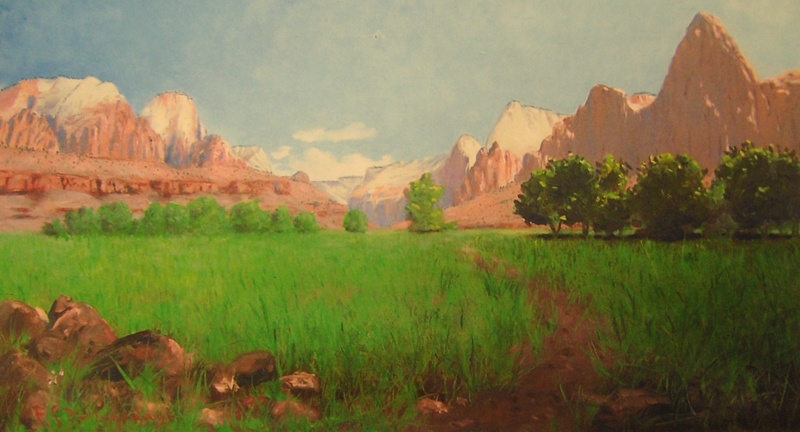
Painting of the entrance to Zion Canyon
by Frederick S. Dellenbaugh in 1903.
|
|
Zion Canyon proper was set aside as a national monument on July 31, 1909 by President Taft and called Mukuntuweap. Explorer John Wesley Powell named the canyon in 1872 using a Paiute word variously defined as "straight arrow", "straight canyon", "straight river", or "land of the springs". Local Mormon pioneers generally referred to it as Little Zion, or Zion Canyon. On March 18, 1918, President Wilson enlarged the monument and changed the name to Zion National Monument. A little over 1-1/2 years later the monument was again enlarged and it attained status of a national park.
|
|
Click on map to enlarge.
|
Interest in the area as a tourist destination had been percolating for a number of years. Late in the fall of 1913 a party of visitors to Zion included Utah Governor Wm. Spry, A.W. Miles, president of the Wylie Permanent Camping Co. in Yellowstone, Howard Hays and Ed Moorman of the Wylie company, Douglas White, of the Salt Lake to Los Angeles rail line (LA&SL), and other Utah promoters who investigated the area for potential tourist development. In August of 1916 another visit was arranged which consisted of the Utah Governor, officials of the Salt Lake rail line and the Oregon Short Line (both companies later came under the corporate umbrella of the Union Pacific RR), Howard Hays, representatives of the White Motor Co. (who were negotiating to provide buses for Yellowstone National Park), along with other promoters to investigate both Zion and the North Rim of Grand Canyon.
1919 map of Zion Canyon showing location
of the Wylie Camp and other park features.
[1919 RR Administration Brochure]
|
The end result of these trips was an offer by railroad officials to bankroll William W. Wylie in establishing tent camps in Zion and Grand Canyon for the 1917 season. The National Park Transportation and Camping Company was formed with W.W. Wylie as president, son Clinton as secretary, and Gronway and Chauncey Parry as vice-president and treasurer respectively. The Parry brothers provided transportation services and the Wylie family set up the camp operation. W.W. Wylie had founded the Wylie camps in Yellowstone in 1883, but had sold out in 1905 after creating a viable and camping business enjoyed by thousands of visitors. Wylie would assign the task of setting up a camp at Bright Angel Point on the North Rim of Grand Canyon to his daughter Elizabeth and her husband Thomas H. McKee.
|
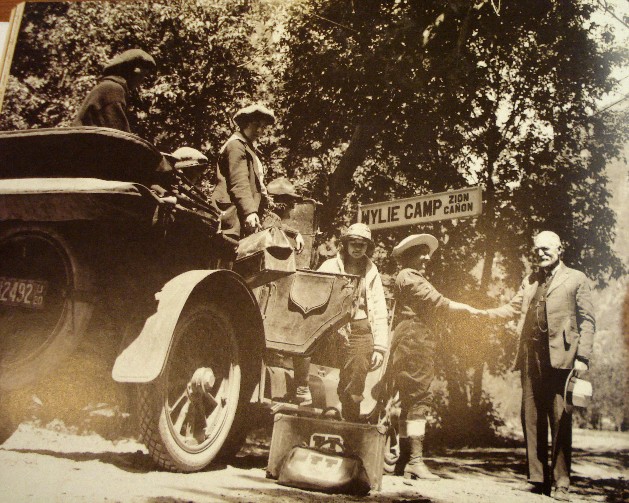
W.W. Wylie greeting guests at the Zion Wylie Camp. Photo coutesy Iron Co. Mission Museum, Cedar City, Ut. |
|
Tour bus negotiating a dry wash enroute to Zion.
Photo courtesy So. Utah University Digital Archives.
|
Visitation was limited that first year but gradually increased as the roads were improved and word of the wondrous sights to be appreciated spread across the land. In 1918 the Parry brothers were off to war and upon their return in 1920 discovered that they had been somewhat unceremoniously ousted from the company by Wylie. Chaunceysuccessfully filed suit to regain their status and ultimately created an independent transportation company that served not only Zion and Grand Canyon parks, but also Bryce, Cedar Breaks and Pipe Springs national monuments.
|
The Wylie camp during these years consisted of a simple tent camp which lay against the cliffs in a shady grove of trees just south of today's Zion Lodge. The camp featured a central assembly hall, dining room, and 10 wood-floored tent-cabins with partial board walls. Each tent-cabin had two double beds separated by a canvas wall down the center, and a separate dressing area. The tents were kept clean, were watertight, had screen doors and were lighted with gas lanterns. Meals were served in the dining room tent on oilcloth-covered tables with linen napkins. Mrs. Wylie and two girls waited on the tables, serving traditional old-fashioned meals. Entertainment included an evening campfire, horse rentals and daily excursions up the canyon. In 1917 patrons could plunk down $26.50 for the 8-hour auto ride to and from Lund via the Parry brothers auto stages. The plan included two meals along the route at Cedar City, with two nights lodging and five meals. Visitors arriving on their own terms or those who continued on beyond the two-night plan paid $3.50/day or $21.00/week. Horses were available for $3.00/day, guides for $4.00/day, and auto tours ran 75 cents/hour.
|
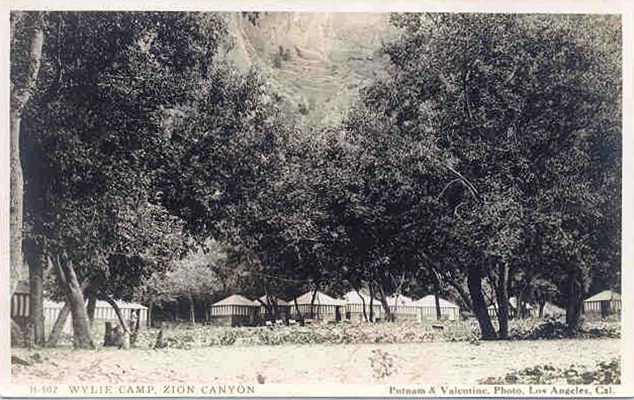 |
Left: H-502 Wylie Camp, Zion Canyon
Postcard, Putnam & Valentine, Los Angeles
Right: Wylie Camp Tent Cabins
So. Utah University Digital Archives
|
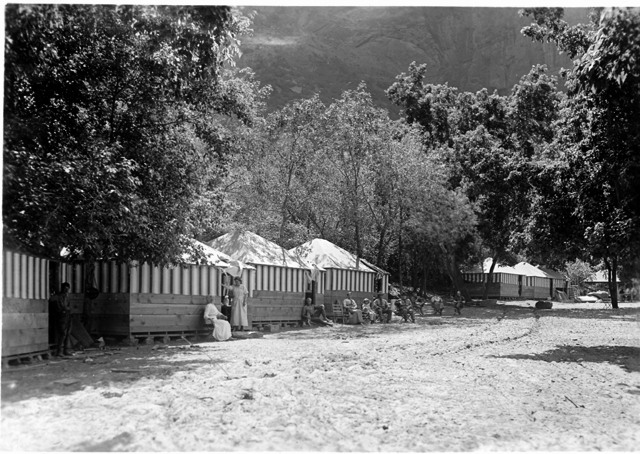 |
| Similar facilities were arranged at the Grand Canyon, which also attained national park status in 1919. Although the operation was limited in the first years, by 1920 the Wylie camp consisted of a central dining tent and sleeping tents to accommodate 25 guests. Rates were $6/day and included meals. 1 and 2-day horseback trips were available at $3/day plus $2.50/day for bedding and provisions. A 3-day trip to the Colorado River cost $5/day per horse with guides running $5/day extra. Eventually an assembly tent was added along with electric lighting for the guest tents. By 1927 the camp could accommodate 75 guests.
McKee family and employees at the North Rim.
Left is Thomas H. McKee, sitting right is Elizabeth
with son Robert standing behind her.
|
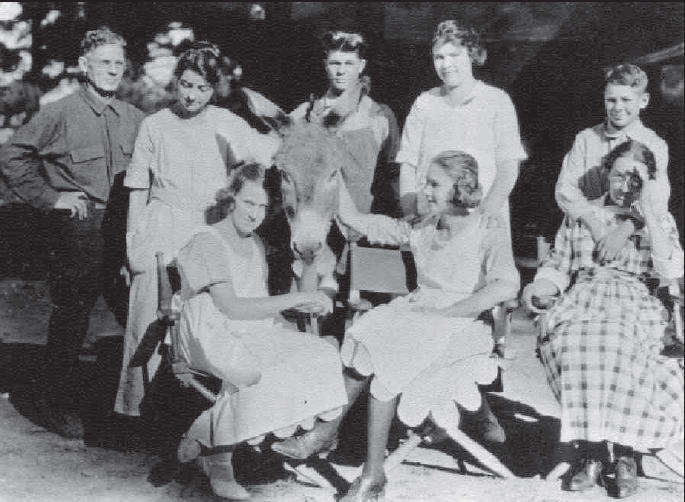 |
| The Zion camp was never a financial success and in 1921 Wylie, now 73 years old, asked the railroad to foreclose on his chattel mortgage and take over the camp. The LA&SL agreed and paid Wylie and his wife $2,000 annually to operate the camps for the 1921-22 seasons. Wylie sold out completely after that and retired. In 1921 the railroad became part of the Union Pacific System and in 1923 formed the Utah Parks Company as a subsidiary to operate the Zion camp with plans to build lodges in Zion, the North Rim, Bryce Canyon and Cedar Breaks. The UPCo operated the Zion camp during the 1923-24 seasons while building a new lodge just north of the camp. They negotiated continued services with the Parry brothers who operated under the name of Utah-Grand Canyon Transportation Company. But in the spring of 1925, the UPCo received permission from the Utah Public Utilities Commission to operate forty 10-passenger touring cars in Zion. They were garaged in Cedar City near the new rail spur that had been built from Lund. The Parrys however continued operations at the other parks. |
 |
Left: Ad for the Zion Wylie Way camp.
Washington County News, June 28, 1917
Right: Union Pacific RR depot at Cedar City
Image courtesy Southern University Digital Archives
|
 |
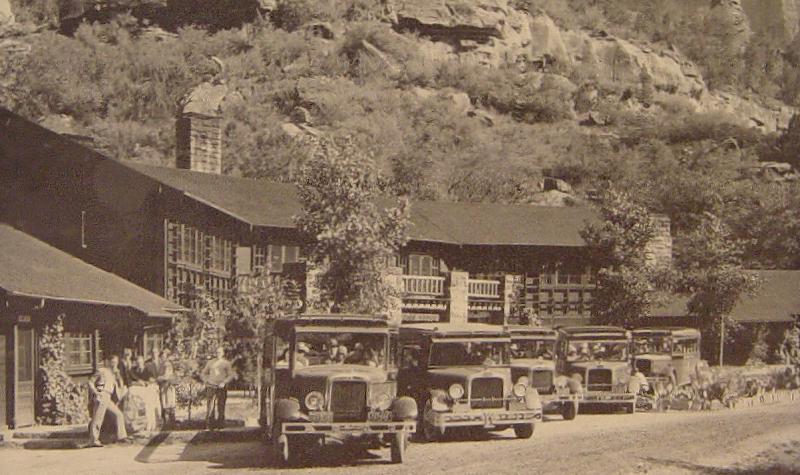
Tour buses lined up in front
of Zion Lodge in 1929.
|
The new Zion lodge was designed by Gilbert Stanley Underwood, who had also designed the Old Faithful Lodge in Yellowstone and the new lodges being constructed in Cedar Breaks and Bryce Canyon. The 2-story lodge opened on May 15, 1925 and included 46 guest cabins (15 more were built the following spring). Huge opening day ceremonies were held on May 18 and were attended by the Utah governor and a variety of local, state, federal and corporate officials. The day celebrated not only the new lodge, but also the improvements made in the road system and the railroad spur to Cedar City, which brought rail visitors closer to the park. 16,817 tourists visited the park that year – twice the previous year.
|
|
The Grand Canyon Wylie Camp continued operations through the 1927 season. That year the NPS solicited bids for a North Rim concessioner that would construct a large lodge facility. The McKees were unable to compete with the corporate giant Union Pacific and the UPCo obtained the contract and began construction of the lodge, under the direction of architect G.S. Underwood. UPCo bought the Wylie Camp for $25,000 and negotiated with Elizabeth and Thomas to operate the camp for the 1927 season. The UPCo also bought out the Parry transportation interests so they could expand their own transportation operation.
The new lodge opened in 1928 with great fanfare, although the official dedication was not held until September 14. More than a million dollars was spent on the facilities and water and power development. The rustic 56,000-square-foot structure was built of native sandstone and rough-hewn ponderosa pine, and designed to blend in with the rugged and rustic location atop the rim of the Grand Canyon. Sleeping accommodations were provided by 100 2-room log lodges and 60 rooms in 20 deluxe lodges, with private bath, fireplace and porches. The operation could sleep 264 guests and offered electric lights, recreation room, lounge, barber shop, 200-person dining room, showers, and other modern luxuries.
|
Grand Canyon Lodge on Bright Angel Point ca1929

1924 map showing the national parks circle route. From a Utah-Arizona Parks Transportation Co. brochure.
|
|
|
It was the beginning of an operation that continues to this day, but the end of the line for the Wylie Way of camping and touring that successfully operated in three of our great national parks. Begun in 1883 in Yellowstone, the Wylie name and tradition of a simple yet fastidious and enjoyable camping experience continued on for 33 years in Yellowstone and 11 years in Zion and Grand Canyon.
|

Wylie Riverside camp remains in Yellowstone |
Today the camps are merely a memory. The astute explorer may find a few vestiges of some of the camps in Yellowstone, but one will find no signboards or plaques commemorating this early history. Nor will you find much if any discussion of this early history in the various park's museums, save for the lobby of the Grand Canyon Lodge where photographs delineate the story of Brighty the mule, who once played a small part in the North Rim Wylie camp. In general, the history and memory of the Wylie camps (and the many other camping companies in Yellowstone) have been unceremoniously erased within the boundaries of the national parks.
|

Wylie Swan Lake Flat camp remains in Yellowstone
|
The success of the Wylie Way was probably matched only by the Curry Company in Yosemite, founded in 1899 by David Curry. He and his wife Jennie also got their start in Yellowstone, and they no doubt looked upon the Wylie Camps as an inspiration and blueprint for their somewhat similar and very successful camp operations.
But that is yet another story . . . .
|
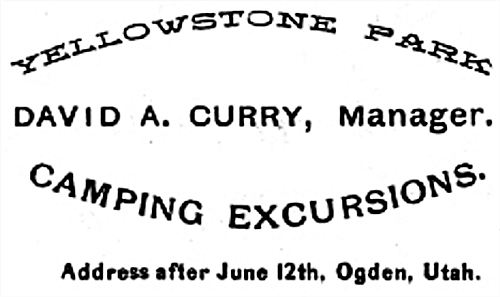 |
Copyright 2014 by Robert V. Goss. All rights reserved.
No part of this work may be reproduced or utilized in any form
by any means, electronic or mechanical, including photocopying,
recording or by an information storage and retrieval system
without permission in writing from the author.
|